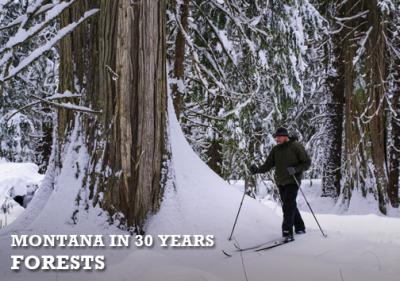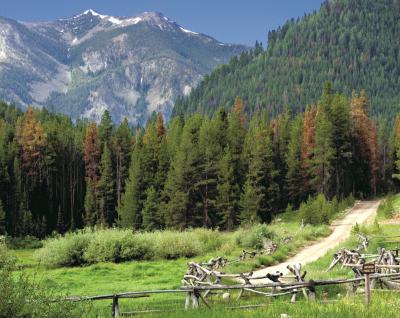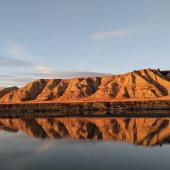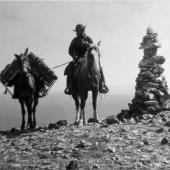Montana in 30 Years: Forests
Interview with Andrew Larson, Ph.d (Associate Professor of Forest Ecology at the University of Montana)

Dr. Andrew J. Larson is Associate Professor of Forest Ecology at the University of Montana. His research examines disturbances and dynamics of natural forest ecosystems. He currently serves as Associate Editor for the journal Fire Ecology, and his fire ecology research in the Bob Marshall Wilderness was recently recognized with the USDA Forest Service National Award for Wilderness Stewardship Research.
Before we take a look at 2045, what kind of shape are our forests in right now, and what are their strengths and weaknesses?
Forestland in Montana has one very important thing going for it — there is still a lot of it. We have not lost our forest landscape to shopping malls, highways, and subdivisions, in contrast to so many other places across the country, such as the Puget Sound country of western Washington, the Colorado Front Range, or the once great deciduous forests of the eastern states. As long as Montana’s forests are not fragmented by development they will remain in a strong position to survive future threats.
However, forests in our state are by no means pristine. Our low elevation, dry forests suffer from the long exclusion of fire. The health and function of ponderosa pine forests in particular depend on recurrent low-severity surface fires. If these dry forests are not burned every 5 to 50 years they accumulate heavy fuel loads and develop unnaturally dense canopies, making them susceptible to extreme fire. The long-standing policies of the US Forest Service and other agencies have been to suppress fire, leading to a great environmental disaster in these dry forests. Smokey Bear got it wrong.

The more productive moist forests of northwest Montana have not been as affected by fire exclusion. In cool and moist forests fires naturally burn less frequently, but with higher severity, killing most trees. Our moist, productive forests are doing fine with respect to fire, but have been subject to more intense harvesting and road building. In both our dry and moist forests the number of large, old trees is greatly diminished compared to historical conditions because of high-grade harvesting. Large diameter trees, which are disproportionately important for wildlife habitat, are much rarer than they were just 50 years ago.
What are the greatest threats to all Montana woodlands over the next 30 years, and which are of most long-term concern?
Probably the single greatest threat to Montana forests is the future introduction of non-native insects and diseases. We have already seen the decimation of the five-needle pine forests throughout Montana and the rest of the West due to white pine blister rust, an introduced disease. Global trade and travel makes the introduction of non-native diseases and tree-killing insects from other parts of the world very likely. My worst case scenario would be the introduction of a non-native disease that kills off one of our major tree species, such as the iconic western larch, much in the way that the non-native chestnut blight disease eliminated the once widespread American chestnut from forests of the eastern United States.
Another major threat to Montana forests is climate change. Over the next 30 years, I expect to see things like increasingly severe and frequent droughts, which will result in widespread tree mortality. But, except for the lower margins of forest cover — the hottest and driest habitats where trees can barely survive now — trees will regenerate and forest cover will persist through at least the initial decades and centuries of climate change. Forests of the future will look very different. Forests will reorganize in response to climate change. Species’ ranges will shift as trees establish in new habitats.
Is there a difference in sensitivity to change and mortality when it comes to old growth vs. new growth trees or different tree species in forested areas?
First, it is important to recognize that tree mortality is a natural, and essential, part of forest dynamics. Dead trees, called snags, provide crucial habitat for wildlife. A forest is only healthy when it has an abundance of snags, and ongoing mortality to supply new snags as the old ones decompose.

Different tree species absolutely have different mortality rates. For example, western larch has very low mortality once it reaches middle age (which for a tree means about 100 years old). Western larch has few natural enemies. Consequently, western larch mortality rates are typically one half to one quarter those of co-occurring tree species such as Douglas-fir or subalpine fir.
Smaller and younger trees typically have higher rates of mortality than large old trees of the same species. This fact often surprises people, as the assumption is that old trees are more likely to die. But, in reality, small and young trees are almost always more likely to die than their older and larger neighbors. One twist to this story is that, in extreme droughts, the oldest and largest trees are more likely to die first. The long term average mortality rate is lower for large old trees, but they are more likely to succumb during extremely stressful periods.
Looking forward to 2045, what will Montana forests look like? Which of Montana’s forests will likely be healthiest, and which seem to be in greatest danger of continued stress and damage?
I expect that the low elevation dry forests will be under the greatest stress and sustaining the highest levels of damage by 2045. These are forests dominated by ponderosa pine, with some Douglas-fir, grand fir, and western larch co-occurring. Unnaturally intense wildfires — largely a result of the misguided policy of fire suppression that caused unnaturally heavy fuel loads to accumulate — will likely be even more common than they are now. These dry forests will likely be experiencing drought-caused tree die off events by 2045. The low elevation forests are also the most likely to be fragmented by development as timber companies sell off their lands.
How will wildlife distribution and patterns of behavior in 2045 be affected by changing forests?
Increasing human population size and resulting fragmentation and loss of forest habitats will be a major driver of wildlife distribution and movement in the future. Wide-ranging animals like grizzly bears need large blocks of habitat with low levels of human use. The development of commercial forestlands — privately owned forests that now produce timber while still providing crucial habitat — into houses, roads, and shopping centers is a huge future threat to Montana’s wildlife.
Wildlife move around in response to natural disturbances like wildfire. As the distribution of forest age classes changes across the landscape, wildlife will respond and move as well. This sort of a shifting habitat mosaic is a normal part of a healthy forest landscape.
Can forests restore themselves if just left alone, or does man need to intervene?
Left alone for long enough, almost any impacted forest can restore itself. But, this assumes that we actually leave the forest alone! Fire is a great example. Many of Montana’s forests depend on fire, yet the standing policy in most areas is to extinguish all fires immediately. This of course only makes the current problem worse because the lack of fire has caused very heavy fuel loads, which in turn increases the likelihood of very severe fires, which most of society will not tolerate. The only alternative is to actively intervene and use mechanical treatments (thinning) and prescribed fire to restore more natural fuel loads and forest densities. From a biological perspective, most forests could recover if left alone. But, that is rarely a socially acceptable option, so we use active management to assist nature.
What are the three most important things that can be done to work toward healthy, sustainable forests of the future?
First, restore fire to our forests. We will always have fires in Montana and the west. Fire is inevitable and unavoidable. The trees in our forests are fire-adapted, and some are even fire-dependent. Fighting fires only makes the current problem worse. We need to be lighting fires — that is, using prescribed fire — instead of fighting fires. We should be focused on putting fire in the forest on our terms, rather than reacting to fires as they start.
Second, do everything possible to prevent introduction of non-native insects and diseases. The potential for a non-native insect or disease to devastate our forests cannot be overstated. We have to safeguard against non-native pathogens and diseases if the forests of the future are to have a chance.
Finally, we need to make forests accessible and important to the next generation. Forest sustainability depends on society valuing forests. If our children and grandchildren do not spend time in the forests, they will not value them. Forests provide valuable timber products and jobs; they provide clean, reliable water for human uses; and they provide recreational opportunities, from hunting to hiking to bird watching. To a very large degree, the future of forest sustainability depends on giving the next generation reasons to value forests.












Leave a Comment Here